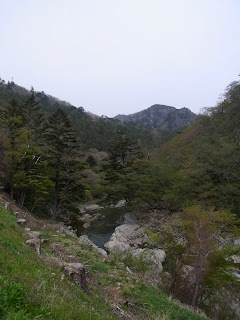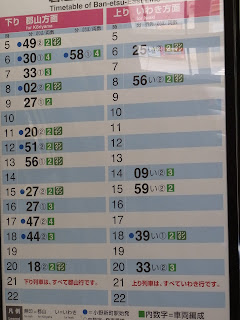The second sitting of holidays of Golden Week (Thurs, Fri, Sat & Sun) has been and gone. The plan was to go up by bike on Thurs and back on Sun. Thursday morning it was pouring. Optimistic checking of the Meteorological Agency's website showed rain the whole way up - Utsunomiya - rain, Fukushima - rain, Sendai - rain, Morioka - rain, Odate... rain. After some deliberation we canned the idea of the bike and trudged off to Tokyo station to join the rest of Tokyo trying to catch a shinkansen... the fast train to Morioka is all booked seats and we didn't have seats... Tokyo station was packed, as expected, but fortune smiled and we got seats on a train to Sendai and tranfered to an express shinkansen for Morioka. It was a bit over 7 hours door to door.
It rained the whole time we were there, which meant that the cherry blossoms had mostly gone and that my plans to go to Goshogake have been postponed again.
The highlight was food...
 |
Mountain veges, shiitake and eggplant. The mountain veges and
shiitake were all given to them by mountain vege picking friends. |
 |
The veges above turned into tempura.
We'd started eating it before I remembered
to take a photo. |
 |
| Shiitake season - partially dried shiitake next to the wood stove |
 |
| Shiitake to be dried. |
 |
Hiro's sister in law and nieces came for dinner. Hiro wanted to do
a yaki niku taste testing session with them.
From left to right across the top Australian kalbi (rib meat),
Japanese dairy kalbi, Australian steak. At the front Japanese dairy kalbi,
New Zealand lamb, and Japanese Wagyu - by far the most expensive of the
meats. The meat came from Aeon (not our choice). There was no
labelling of which prefectures the meat came from, which I assume
means they came from areas in relatively close proximity to the
nuclear plant (all meat from the area is being tested and I don't have
concerns about radiation levels - I am less confident about fish and veges.)
In Tokyo all meat seems to labelled by prefecture or region these days. |
 |
A close up of the posh meat 698Y/100g - some cuts of
wagyu can easily be 10x the price of this in a very upmarket shop. |
 |
| Mountain veges soaking. |






















































